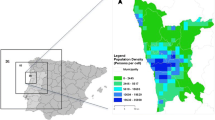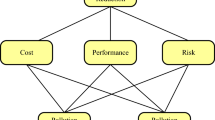Abstract
The traditional strategy for ground-level ozone control is to apply emission reductions across the board throughout certain time periods and locations. In this paper, we study various mixed integer linear programming (MILP) models that seek to select targeted control strategies for the Dallas Fort-Worth (DFW) region to reduce emissions, in order to achieve the State Implementation Plan (SIP) requirements with minimum cost. Statistics and optimization methods are used to determine a potential set of cost-effective control strategies for reducing ozone. These targeted control strategies are specified for different types of emission sources in various time periods and locations. Three MILP models, a static model, a sequential model, and a dynamic model, are studied in this research. These different MILP models allow decision makers to study how the targeted control strategies change under different circumstances. Meanwhile, two types of auxiliary variables are considered as supplemental control strategies in the optimization if the current set of control strategies is unable to reduce ozone to comply with the 8-h ozone standard. Results from the different models can provide decision makers with information concerning how the effectiveness of the control strategies varies with daily emission patterns and meteorology.
Similar content being viewed by others
References
Environmental Protection Agency (EPA) (2010c). Pollutants in the ambient air. http://www.epa.gov/apti/course422/ap2.html. Accessed June 10, 2012.
Environmental Protection Agency (EPA) (2010d). Air pollution monitoring. http://www.epa.gov/oaqps001/montring.html. Accessed June 10, 2012.
Environmental Protection Agency (EPA) (2010e). Air quality trends. http://www.epa.gov/airtrends/2011/report/highlights.pdf. Accessed June 10, 2012.
Environ International Corporation (2011). “User’s Guide: Comprehensive air quality model with Extensions Version 5.40”, September.
Texas Commission on Environmental Quality (TCEQ) (2007). Dallas-Fort Worth attainment and reasonable further progress demonstrations for the 1997 eight-hour ozone standard, Project No. 2006-013-SIP-NR, 05/23/2007. http://tceq.state.tx.us/implementation/air/sip/dfw_revisions.html. Accessed 25 November, 2010.
North Central Texas Council of Governments (NCTCOG) (2010b). Dallas-Fort Worth 1-hour nonattainment area. http://www.nctcog.org/trans/air/ozone/1-Hourmap.pdf. Accessed 25 November, 2010.
Hubbard, M. C., & Cobourn, W. G. (1998). Development of a regression model to forecast ground-level ozone concentration in Louisville, KY. Atmospheric Environment, 32(14), 2637–2647.
Pires, J., Martins, F., Sousa, S., Alvim-Ferraz, M., & Pereira, M. (2008). Selection and validation of parameters in multiple linear and principal component regressions. Environmental Modelling and Software, 23(1), 50–55.
Abdul-Wahab, S. A., Bakheit, C. S., & Al-Alawi, S. M. (2005). Principal component and multiple regression analysis in modelling of ground-level ozone and factors affecting its concentrations. Environmental Modelling & Software, 20(10), 1263–1271.
Barrero, M. A., Grimalt, J. O., & Canton, L. (2006). Prediction of daily ozone concentration maxima in the urban atmosphere. Chemometrics and Intelligent Laboratory Systems, 80(1), 67–76.
Shih, J.-S., Russell, A. G., & McRae, G. J. (1998). An optimization model for photochemical air pollution control. European Journal of Operational Research, 106(1), 1–14.
Fu, J. S., Brill, E. D., Jr., & Ranjithanc, S. R. (2006). Conjunctive use of models to design cost-effective ozone control strategies. Journal of Air and Waste Management Association, 56, 800–809.
Cohan, D. S., Tian, D., Hu, Y., & Rusell, A. G. (2006). Control strategy optimization for attainment and exposure mitigation: case study for ozone in Macon. Georgia. Environmental Management, 38(3), 451–462.
Cohan, D. S., Boylan, J. W., Marmur, A., & Khan, M. N. (2007). An integrated framework for multipollutant air quality management and its application in Georgia. Environmental Management, 40, 545–554.
Gao, H. O., & Niemeier, D. A. (2008). Using functional data analysis of diurnal ozone and NOx cycles to inform transportation emissions control. Transportation Research Part D: Transport and Environment, 13(4), 221–238.
Guariso, G., Pirovano, G., & Volta, M. (2004). Multi-objective analysis of ground-level ozone concentration control. Journal of Environmental Management, 71(1), 25–33.
Sanhueza, P. A., Reed, G. D., Davis, W. T., & Miller, T. L. (2003). An environmental decision-making tool for evaluating ground-level ozone-related health effects. Journal of the Air & Waste Management Association, 53(12), 1448–1459.
Schopp, W., Amann, M., Cofala, J., Heyes, C., & Klimont, Z. (1999). Integrated assessment of European air pollution emission control strategies. Environmental Modelling and Software, 14, 1–9.
Sule, N. V., Sattler, M. L. and Chen, V. C. P. (2008). Assessing control strategies for ground level ozone. Proceedings of the 101st Air & Waste Management Association Annual Conference, Portland, OR, June, Paper #492.
Sule, N. V., Chen, V., & Sattler, M. (2011). A decision making framework for assessing control strategies for ground level ozone. Atmospheric Environment, 45, 4996–5004.
Yang, Z., Chen, V. C. P., Chang, M. E., Murphy, T. E., & Tsai, J. C. C. (2007). Mining and modeling for a metropolitan Atlanta ozone pollution decision-making framework. IIE Transactions Special Issue on Data Mining, 39(6), 607–615.
Yang, Z., Chen, V. C. P., Chang, M. E., Sattler, M. L., & Wen, A. (2009). A decision-making framework for ozone pollution control. Operations Research, 57(2), 484–498.
Texas Commission on Environmental Quality (TCEQ) (2010c). 8 hour attainment demonstration SIP: Control Strategies Lists, FINAL Report from ENVIRON. http://www.nctcog.org/trans/air/sip/future/lists/Environ.pdf. Accessed 25 November 2010.
Hsu, W. C., Rosenberger, J. M., Chen, V. C. P., Sattler, M. L., & Sule, N. V. (2013). Optimizing ground-level ozone control strategies with mixed integer nonlinear programming. COSMOS technical report. Arlington, TX: The University of Texas at Arlington.
Author information
Authors and Affiliations
Corresponding author
Rights and permissions
About this article
Cite this article
Hsu, WC., Rosenberger, J.M., Sule, N.V. et al. Mixed Integer Linear Programming Models for Selecting Ground-Level Ozone Control Strategies. Environ Model Assess 19, 503–514 (2014). https://doi.org/10.1007/s10666-014-9408-4
Received:
Accepted:
Published:
Issue Date:
DOI: https://doi.org/10.1007/s10666-014-9408-4




